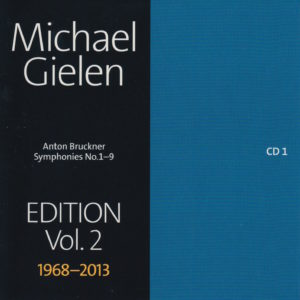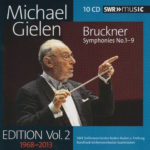 This morning’s conductor of Anton Bruckner’s Symphony No. 1 in C Minor is Michael Gielen (1927-), an Austrian conductor and composer with a very long and lauded career who just recently (2014) retired from conducting for health reasons.
This morning’s conductor of Anton Bruckner’s Symphony No. 1 in C Minor is Michael Gielen (1927-), an Austrian conductor and composer with a very long and lauded career who just recently (2014) retired from conducting for health reasons.
Gielen, like conductor Riccardo Chailly, chose Bruckner’s revised (1891) Vienna version of Symphony No. 1 in C Minor (WAB 101).
The orchestra for this performance is SWR Baden-Baden Freiburg Symphony Orchestra (Southwest German Radio Symphony Orchestra), the chief conductor of which (during the years 1986–1999, according to Wikipedia) was Michael Gielen.
 The recording of this particular symphony was, I think, made in 2009. If so, Gielen would have been 82. Bruckner, when he edited his Symphony No. 1 was 67.
The recording of this particular symphony was, I think, made in 2009. If so, Gielen would have been 82. Bruckner, when he edited his Symphony No. 1 was 67.
It’s hard to say for sure when Gielen’s performance was recorded. The credits for the CD liner notes are mostly in German. However, some of the essays within have been translated into English. One of them – an essay titled “Axe Hewn” by Paul Fiebig – tells us,
Michael Gielen had his first chance to conduct broadcast performances of the symphonies of Anton Bruckner and record them on tape in the late 1960s.
How about the oft-heard assertion that Bruckner composed all his symphonies to the same pattern? Michael Gielen can only shake his head: “You can’t say that. Five and Six really don’t follow the same pattern, let alone Eight and Nine.” Even with the others, though, any such classification would be superficial at best. In any case, Bruckner symphonies were never intended to prompt the same reactions every time.
No question, then, that Bruckner made his symphonies sound “typically Brucknerian” from the start. Take the First, composed in 1865/66 and known as the Linz Symphony (Bruckner had been Cathedral organist in Linz for a decade by then); he saw it as a “saucy wench,” but conductor Hans von Bulow soon discovered “glory,” “boldness” and “drama” in it. A quarter-century passed before the revised Vienna edition was offered to the city’s university acknowledgement of his honorary doctorate. So “at the start,” as Bruckner related, the Vienna Philharmonic Orchestra took it “for the work of a madman,” and in the end pronounced it “phenomenal.”
Bruckner wrote his symphonies in four parts. The breakdown of this one (1891 Vienna version), from this particular conductor (Gielen) and this particular orchestra (SWR Baden-Baden Freiburg Symphony Orchestra), is as follows:
Allegro…………..13:53
Adagio……………12:59
Scherzo……………9:20
Finale……………..15:45
By way of contrast, this was the running time for each of the four movements in yesterday’s performance by conductor Gerd Schaller:
Allegro…………..14:12
Adagio……………12:52
Scherzo……………8:59
Finale……………..15:32
The differences in time between these two performances isn’t as noticeable as the differences between yesterday’s performance and the day before that. In this case, in Gielen’s version, the difference is only one minute – a mere :60 – over all four movements.
That tells me the differences I’ve heard so far are likely the conductor’s choice of tempo, not necessarily because of the revisions Bruckner made to Symphony No. 1.
Those were the objective stats. Here are the subjective ones:
My Rating:
Recording quality: 5
Overall musicianship: 5
CD liner notes: 3 (some essential information hard to discern because it’s written in German)
How does this make me feel: 2
This is an odd one for me.
The recording was superb.
The performance was also superb.
Yet, this didn’t move me. It seemed so, for want of a better word, big.
Bold. Grand. Robust. Full. Rich.
I especially hear this in the lushness of Movement I (Allegro). It is a huge performance. But therein lies the issue for me. I feel like an outsider to this performance. I’m watching it. I’m not in it.
That’s such a subjective statement I can’t even believe I typed it. And it may be prematurely harsh. However, I’ve listened to Gielen’s entire performance of Symphony No. 1 three times, and yet I still don’t feel a connection to it.
The intimacy of, say, the last minute of Adagio (Movement Two) that I heard in Gerd Schaller’s performance wasn’t there this time. Whereas Schaller left me perched on the edge of my seat (Barenboim was that way, too), Gielen’s did not. Neither did Chailly’s. I didn’t get that sense of awe and wonder at the end of Adagio.
Someone uploaded Gielen performance of Bruckner’s Symphony No. 1 to YouTube. This is precisely what I’ve been listening to this morning.
Here’s Adagio (Movement II) from Symphony No. 1.
Here’s the last minute of Movement II, which has become the standard by which I judge the performances. If the last :60 moves me, leaves me with a sense of awe and wonder, thumbs up, baby. If it doesn’t, thumbs…well, sideways. The performances are still remarkable. They just don’t move me.
There’s no doubt in my mind this is a beautiful piece of music. It is remarkable.
But I wasn’t hanging on every note the way I was with, say, Schaller’s version. Or Barenboim’s version.
So, that’s how I’ll leave this review.
It’s stunning. One of the most beautifully rendered so far.
It just doesn’t move me.
Ear of the beholder, eh?
